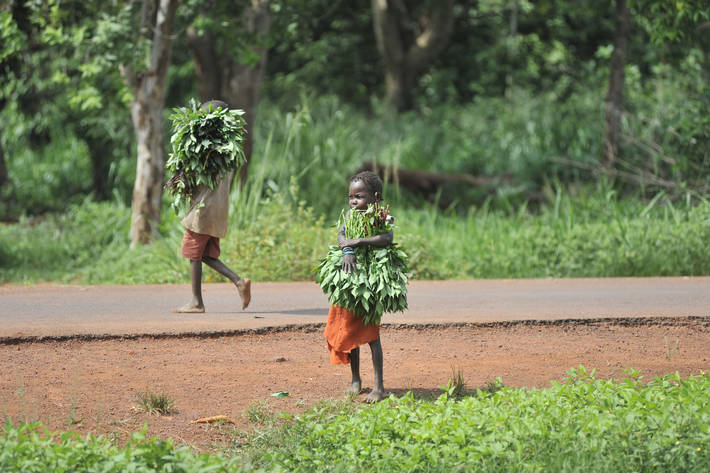The Food and Agriculture Organization of the United Nations (FAO) today urged nations to pay greater attention and allocate more financial resources to addressing child labour in domestic and local food supply chains and in subsistence farming where the vast majority of child labour in agriculture occurs.
The call for action was made as FAO observed World Day Against Child Labour at a global conference “United to End Child Labour in Agriculture”, which the UN agency co-organised with the European Commission’s Directorate -General for International Cooperation and Development (DEVCO), and the International Labour Organization (ILO), in Brussels, Belgium.
Currently almost all dedicated financial resources for fighting child labour are channelled towards addressing child labour in global supply chains whereas the child labour situations in small-scale producers remain largely neglected, FAO warned.
“It is time we go beyond the exclusive focus on selected global supply chains and begin investing resources into tackling child labour in all situations,” said FAO’s Director-General José Graziano da Silva in a video message recorded for this year’s World Day Against Child Labour. “It is also essential to engage the agricultural workers and producer organisations.”
Graziano da Silva also highlighted the crucial role of the International Partnership for Cooperation on Child Labor in Agriculture, founded by the ILO, FAO and other partners. “Only together we can create change for a better, healthier and more prosperous future for our children,” he said.
Need to address root causes of child labour
Of the 152 million children in child labour situations around the world more than 70 percent or 108 million girls and boys between the ages of 5 and 17 work in farming, livestock, forestry, fishing or aquaculture. The number of children in child labour in agriculture has increased by 10 million since 2012. Moreover, 85 percent of child labour in Africa is found in the agriculture sector.
Some of the key factors that contribute to child labour in rural areas are low family incomes and household poverty, few livelihood alternatives, poor access to education and limited labour law enforcement.
In his remarks, the FAO chief said, “Household poverty remains a common cause of child labour in agriculture. In this context, social protection programmes and school feeding initiatives that link with family farmers are proven to be good antidotes against child labour”.
What is child labour?
Child labour is defined as work that is inappropriate for a child’s age, prevents a child to benefit from compulsory education, or is likely to harm their health, safety or morals.
In this context, the FAO Director-General noted that not all participation by children in agriculture should be considered child labour. For example, girls and boys learning how to grow vegetables or feed the chickens in their families’ farm can sharpen their skills and improve future livelihoods, he said.
“However, when children work many hours daily, when they do heavy work, when they carry out tasks that are dangerous or inappropriate for their age, when this impedes their education, this is child labour, and needs to be eliminated,” he stressed.
Furthermore, when children work in fields where pesticides have been applied, stay up all night on fishing boats, carry heavy loads, or use chain saws in the forest, it can interfere with their social and physical development and hence the ability to access decent and productive employment opportunities later in life.
Stepping up global efforts for Zero Child Labour
Child labour in agriculture is a global issue that is harming children and damaging the agriculture sector by perpetuating rural poverty. We will not be able to achieve the Sustainable Development Goals, if we continue to leave this by far largest group of child labourers in agriculture behind, FAO stressed today. More investments and dedicated resources need to be allocated to addressing child labour in agriculture.
“To make progress towards Zero Child Labour (SDG 8.7), the international community needs to reach scale, which will not be achieved through the continuation of a few dedicated child labour programmes and projects,” said FAO Assistant Director-General for Economic and Social Development, Maximo Torero Cullen.
He highlighted the need to develop cross-sectoral multi-stakeholder approach to ensure that policies, strategies, national and other large-scale programmes in agriculture, rural development, education, health, food security, poverty reduction, youth employment, social protection, community development, infrastructure, and trade include specific measures and components that help prevent and mitigate child labour.
“Each of these sectors and work areas have concrete potential to substantially contribute to the progress towards ending child labour, which are largely untapped,” Torero said.
The conference brought together EU institutions, international organisations, governmental institutions and non-governmental organisations, partner countries, resource partners, private sector, academia, researchers, agricultural workers’ and producers’ organisations and consumers’ organisations to share experiences and discuss concrete opportunities to end child labour in agriculture.
Photo Credit: FAO
UN agency calls for global push to tackle child labour in agriculture




